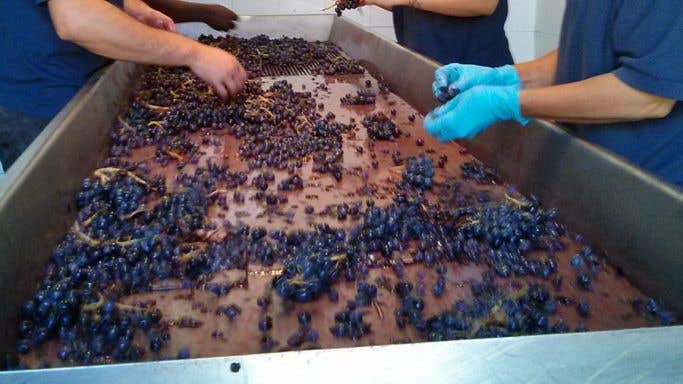Miquel Hudin of the Vinologue series of wine guides sends this report from Barcelona, where he is based.
At the beginning of May I stopped in to visit a garagiste winemaker friend in the Catalan village of Capçanes. He was out removing excess growth in his small two-hectare vineyard of Garnatxa Peluda (Lladoner Pelut) and Carinyena (Carignan) and looked up from the work to say, ‘Miquel, I can feel it. This is going to be a great harvest.’ Fast forward five months to the end of September when, with a group of friends, we harvested that same vineyard, tossing countless rotten bunches on the ground, skipping some rows entirely, and selecting grape by grape in others, with around 60% in total loss.
Such is the case this year for a lot of winemakers in Greater Priorat (in both DOQ Priorat and DO Montsant). As elsewhere in Europe, for all of 2014 and particularly during the summer, the weather had been strange and unpredictable. The white grape harvest went well overall, but for the reds it proved tough as, not only did coulure severely affect the flowering of the Garnatxa (Grenache) grapes (see Coulure shrinks 2013 Grenache crop), but it has been so damned wet. The rains started at the end of September just as the grapes in this region typically find their sweet spot in maturity, and continued in a region where the harvest often carries on well in to October and sometimes the start of November.
Beyond the inopportune rains, the normally drying winds haven’t been doing their job this year. Typically you get a little bit of rain here and there but then the garbinada dries it out and the problem is solved. This year, nothing. The days and nights have been still and the humidity has ramped up to 80% by morning. This in turn has translated into piles of botrytis and rot. Most of the DOQ Priorat vineyards have been spared the harsh conditions that have afflicted DO Montsant – especially the southern Montsant villages which, in addition to being slammed by hail earlier, have had hellish, humid weather this year.
The co-operative Celler de Capçanes confirmed that the hail led to a difficult start to the growing season. While the winegrowers treated the vineyards quickly after the storms in late spring, the key issue was that the hail strikes led to a longer maturation time on the vine, which in this soggy, cool year was obviously problematic.
I helped another friend in the village of Porrera harvest his family vineyard whose grapes are sold to Scala Dei. In that vineyard we had to discard a lot of Grenache in some locations depending on the orientation, but it wasn't anywhere near the extent of what was seen further south. My friend Ricard Rofes, the oenologist of Scala Dei, said that indeed it was an atypical harvest in 2014 with a very cool summer that led to late ripening amid a disagreeable lack of sun.
But this is all the doom and gloom that everyone has been talking about to date. Most know that viticulture is a horribly stressful occupation that I posit is up there with being an air traffic controller. As the wines have started to complete fermentation and the results are being seen, there has been a silver lining to all of this, best described with the magic word ‘fresh’. This is not to be equated with ‘a winemaker's year’ often used further north as code for ‘we'll fix it in the cellar’. These wines are shaping up to be quite good and all this talk about a fresh year echoes what a winemaker once told me: ‘If you can make a wine in Priorat, it’s a good year.’
DO Montsant is also seeing similar results with ‘fresh’ being the name of the vintage. For those who are familiar with the wines of Greater Priorat, the fact that the wines of 2014 will indeed be a good deal lighter than 2013 isn't perhaps a bad thing, and could indeed be quite interesting as the last 15 years have seen so many more winemakers truly expressing terroir as opposed to just mentioning it in brochures.
Fortunately, a great number of vineyards, such as Scala Dei’s high-altitude Garnatxa and the old-vine Carinyena seen in Vall Llach's gorgeous Mas de la Rosa vineyard in Porrera that I helped harvest as well, were unaffected by the foul weather. The grapes on the vine indeed showed a fresh character but they still carried all that lovely, layered nuance that old-vine Carinyena expresses so well.
The most interesting aspect of all of this is that there was no decrease in grape production, despite the amount of grapes that had to be discarded. This was a year when the sorting table was every winemaker's best friend. DOQ Priorat has released official figures that show that 5.5 million kg of grapes were harvested, which is a 3% increase over the 5.35 million in 2013. At Capçanes what initially looked to be a 10-20% decrease on the year before ended up as the same quantity as 2013.
So, the good news for lovers of DOQ Priorat & DO Montsant wines (such as myself, very much) is that it will be a different, fresher and lighter vintage than usual, but there won't be any less of it despite a 19% decrease in Spanish wine production overall in 2014. Even the hobbyists of Greater Priorat who make garage wines when not at their day jobs making wine at larger cellars eventually found enough grapes to play with. Everyone in the region is starting to scrub the dark purple stains out of their fingernails, to exhale, and to do what all winemakers do at the end of harvest: have a beer.
